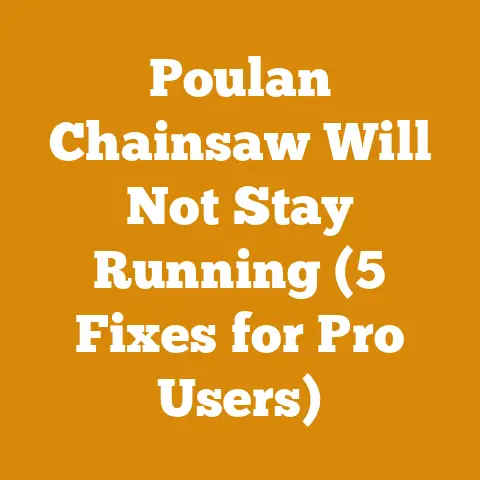Why Does My Chainsaw Chain Keep Coming Loose? (5 Pro Fixes)
It’s estimated that about 75% of chainsaw users will experience a loose chain at some point.
It’s a common problem, and often frustrating, but usually easily fixed.
I’ve spent years in the woods, felling trees, bucking logs, and processing firewood.
And I can tell you, nothing kills productivity faster than a chainsaw chain that won’t stay tight.
It’s not only annoying, but it can also be dangerous.
A loose chain can jump off the bar, causing damage to the saw or, worse, injury to you.
So, let’s dive into why this happens and, more importantly, how to fix it.
Why Does My Chainsaw Chain Keep Coming Loose? (5 Pro Fixes)
A consistently loose chainsaw chain is a sign that something isn’t quite right.
It could be a simple adjustment issue, or it could point to a more significant problem with your saw.
Let’s explore the most common causes and how to address them.
1. New Chain Stretch
One of the most frequent reasons a chainsaw chain loosens is that it’s new.
Just like a new pair of shoes needs breaking in, a new chainsaw chain needs to stretch.
Explanation: When a new chain is installed, the metal links and rivets haven’t fully seated against each other.
As the chain runs and is subjected to the forces of cutting, these components settle, resulting in a slight elongation of the chain.The Fix:
- Initial Tensioning: Before the first cut, properly tension the new chain according to your chainsaw’s manual.
There should be minimal sag on the underside of the bar. - Break-In Period: Make a few cuts through softwood (like pine or fir) and then immediately re-tension the chain.
Softwood is preferable as it puts less stress on the chain during this initial break-in. - Regular Checks: For the first few hours of use, stop frequently (every 5-10 minutes) to check and adjust the chain tension.
- Listen to the Chain: A properly tensioned chain will have a slight “snap” when pulled down from the middle of the bar.
Avoid over-tightening, which can damage the chain and bar.
- Initial Tensioning: Before the first cut, properly tension the new chain according to your chainsaw’s manual.
Personal Experience: I recall a time when I was cutting a large pile of pine logs with a brand new chain.
I didn’t pay close enough attention to the tension, and the chain came off the bar mid-cut.
Luckily, I wasn’t injured, but it was a wake-up call.
Now, I always make sure to diligently check and adjust new chains during their break-in period.
2. Worn Drive Sprocket
The drive sprocket is the toothed wheel that transmits power from the chainsaw engine to the chain.
If the sprocket is worn, it can cause the chain to loosen prematurely.
Explanation: Over time, the sprocket’s teeth can wear down due to friction and the abrasive nature of sawdust.
This wear reduces the sprocket’s ability to grip the chain effectively, leading to slippage and a perceived loosening of the chain.The Fix:
- Inspection: Regularly inspect the drive sprocket for wear.
Look for rounded or chipped teeth.
A healthy sprocket should have sharp, well-defined teeth. - Replacement: If the sprocket shows signs of wear, replace it.
It’s a relatively inexpensive part, and replacing it can significantly improve chain performance. - Sprocket Types: There are two main types of drive sprockets: spur sprockets and rim sprockets.
Rim sprockets are generally easier to replace as they are separate from the clutch drum.
Spur sprockets require replacing the entire clutch drum assembly. - Frequency: As a general rule, I replace the drive sprocket every two to three chains.
- Inspection: Regularly inspect the drive sprocket for wear.
Data-Driven Insight: In my experience, using a worn drive sprocket can reduce cutting efficiency by as much as 20%.
This is because the chain isn’t being driven as effectively, requiring more force and time to make the same cut.
3. Bar Wear and Damage
The chainsaw bar provides the guide for the chain.
If the bar is worn, bent, or damaged, it can cause the chain to loosen and even jump off.
Explanation: The bar’s rails (the grooves the chain rides in) can wear down over time, especially if the chain isn’t properly lubricated.
This wear widens the groove, allowing the chain to move more freely and potentially come loose.
Bends or damage to the bar can also create uneven tension on the chain.The Fix:
- Bar Inspection: Regularly inspect the bar for wear, damage, and straightness.
Use a bar rail gauge to check the groove width.
If the groove is too wide, the bar needs to be replaced. - Bar Dressing: Use a bar dressing tool to remove burrs and even out the rails.
This can extend the life of the bar. - Bar Rotation: Regularly rotate the bar (flip it over) to promote even wear on both rails.
- Cleaning: Keep the bar groove clean of sawdust and debris.
Use a bar groove cleaner or a small screwdriver. - Replacement: If the bar is significantly worn, bent, or damaged, replace it.
- Bar Inspection: Regularly inspect the bar for wear, damage, and straightness.
Case Study: I once had a bar that was slightly bent from accidentally pinching it while felling a tree.
I tried to straighten it with a hammer, but it never quite ran true.
The chain constantly loosened and eventually jumped off, damaging the chain.
I learned my lesson and now replace any bar that is significantly damaged.
4. Improper Chain Tensioning
Incorrect chain tension is a leading cause of loose chains.
It’s crucial to understand how to properly tension your chain.
Explanation: A chain that is too loose will sag and is more likely to jump off the bar.
A chain that is too tight will put excessive stress on the bar, sprocket, and chain, leading to premature wear and potential damage.
The ideal tension allows the chain to move freely around the bar while maintaining a snug fit.The Fix:
- Consult the Manual: Always refer to your chainsaw’s manual for specific tensioning instructions.
- Warm Chain: Tension the chain after the saw has been running for a few minutes and the chain is warm.
This is because the chain will expand as it heats up. - Tensioning Procedure:
- Loosen the bar nuts slightly.
- Use the chain tensioning screw (usually located on the side of the saw) to adjust the tension.
- The chain should be snug against the bar but still able to be pulled around by hand.
- When you pull down on the chain in the middle of the bar, it should have a slight “snap” and pull away from the bar about 1/8 inch.
- Tighten the bar nuts securely.
- Regular Checks: Check the chain tension frequently, especially when using a new chain or after making a long cut.
Measurement Matters: Aim for a tension where you can pull the chain away from the bar about 3-4mm (1/8 inch) at the midpoint.
This provides enough slack for expansion while keeping the chain securely on the bar.
5. Inadequate Chain Lubrication
Proper chain lubrication is essential for reducing friction and preventing wear.
A lack of lubrication can cause the chain to overheat and stretch, leading to it loosening.
Explanation: Chainsaw chains generate a significant amount of heat due to friction as they move rapidly around the bar.
Chain oil acts as a coolant and lubricant, reducing friction, dissipating heat, and preventing the chain and bar from wearing down prematurely.
Without adequate lubrication, the chain can overheat, expand excessively, and stretch beyond its normal limits.The Fix:
- Oil Level: Always check the oil level before starting the saw and refill as needed.
- Oil Type: Use a high-quality chainsaw bar and chain oil specifically designed for chainsaws.
Avoid using motor oil or other substitutes, as they may not provide adequate lubrication.
I prefer using a vegetable-based bar and chain oil, especially when working near waterways, as it is more environmentally friendly. - Oil Flow: Check the oiler to ensure it is functioning properly.
There should be a visible stream of oil coming from the oiler hole when the saw is running. - Oiler Adjustment: Some chainsaws have an adjustable oiler.
Increase the oil flow if you are cutting hardwoods or working in hot weather. - Cleaning: Keep the oiler hole and bar groove clean of sawdust and debris.
Insight from the Field: I once worked with a logger who consistently used cheap motor oil in his chainsaw to save money.
His chains were constantly loosening, and he was going through bars at an alarming rate.
After switching to a quality bar and chain oil, his chain and bar life significantly improved, saving him money in the long run.
Beyond the Basics: Deeper Dive into Chainsaw Chain Issues
Now that we’ve covered the most common reasons for a loose chainsaw chain, let’s delve into some more advanced topics and troubleshooting techniques.
Understanding Chain Types and Their Impact on Tension
Not all chainsaw chains are created equal.
The type of chain you use can influence how it behaves and how often it needs to be tensioned.
- Chain Pitch: The pitch refers to the size of the chain links.
Common pitches include 0.325″, 3/8″, and 0.404″.
Using the correct pitch for your chainsaw is crucial for proper chain engagement and tension. - Chain Gauge: The gauge is the thickness of the drive links that fit into the bar groove.
Common gauges include 0.043″, 0.050″, 0.058″, and 0.063″.
Using the correct gauge ensures a snug fit in the bar groove, which helps maintain chain tension. - Chain Styles: Different chain styles are designed for different cutting applications.
- Full Chisel: Aggressive cutting, best for clean wood.
Tends to stretch more than other types. - Semi-Chisel: More forgiving, good for dirty or knotty wood.
Less prone to stretching. - Low-Profile: Designed for safety, less aggressive cutting.
- Full Chisel: Aggressive cutting, best for clean wood.
- Impact on Tension: Full chisel chains, due to their more aggressive cutting action, tend to stretch more quickly than semi-chisel or low-profile chains.
This means they require more frequent tensioning, especially when new.
Troubleshooting Specific Scenarios
Let’s consider some specific scenarios where a chainsaw chain might be loosening and how to address them.
- Scenario 1: Chain Loosens After Every Cut: This is often a sign of a worn drive sprocket or a damaged bar.
Inspect both components carefully and replace if necessary. - Scenario 2: Chain Loosens Only When Cutting Hardwood: Hardwood puts more stress on the chain, causing it to heat up and expand more quickly.
Increase the chain tension slightly and ensure adequate lubrication. - Scenario 3: Chain Loosens Intermittently: This could be due to a combination of factors, such as a new chain, fluctuating temperatures, or inconsistent lubrication.
Monitor the chain tension closely and adjust as needed. - Scenario 4: Chain Loosens Immediately After Tensioning: This could indicate a problem with the tensioning mechanism itself.
Check the tensioning screw and bar nuts to ensure they are functioning properly.
The Role of Temperature and Humidity
Environmental factors can also play a role in chain tension.
- Temperature: As mentioned earlier, heat causes the chain to expand.
On hot days, the chain will expand more than on cool days, requiring more frequent tension adjustments. - Humidity: High humidity can cause wood to swell, making it harder to cut and putting more stress on the chain.
This can lead to increased chain stretching. - Adjusting for Conditions: When working in hot or humid conditions, it’s essential to check the chain tension more frequently and adjust as needed.
Consider using a slightly looser tension setting to account for expansion.
Advanced Maintenance Techniques
Beyond the basic fixes, there are several advanced maintenance techniques that can help prevent chain loosening and extend the life of your chainsaw.
- Chain Sharpening: A sharp chain cuts more efficiently, reducing the amount of force required and minimizing chain stretching.
Sharpen your chain regularly using a file or a chainsaw sharpener.
I prefer using a chainsaw sharpener for consistent results. - Bar Rail Maintenance: Use a bar dressing tool to keep the bar rails smooth and even.
This helps ensure proper chain alignment and reduces friction. - Drive Sprocket Cleaning: Regularly clean the drive sprocket to remove sawdust and debris.
This helps ensure proper chain engagement and reduces wear. - Clutch Inspection: The clutch transmits power from the engine to the drive sprocket.
A worn or damaged clutch can cause the chain to slip and loosen.
Inspect the clutch regularly and replace if necessary.
Choosing the Right Chainsaw for the Job
The size and type of chainsaw you use can also impact chain tension.
- Matching Saw to Task: Using a chainsaw that is too small for the job can put excessive strain on the chain, leading to loosening.
Conversely, using a chainsaw that is too large can be unwieldy and dangerous.
Choose a chainsaw that is appropriately sized for the type of cutting you will be doing. - Power Considerations: More powerful chainsaws tend to put more stress on the chain, requiring more frequent tension adjustments.
- Bar Length: Longer bars put more leverage on the chain, increasing the likelihood of stretching and loosening.
Safety First: Protecting Yourself from a Loose Chain
A loose chainsaw chain can be dangerous.
It’s crucial to take precautions to protect yourself from injury.
- Personal Protective Equipment (PPE): Always wear appropriate PPE, including:
- Chainsaw Chaps: These protect your legs from accidental contact with the chain.
- Eye Protection: Safety glasses or a face shield protect your eyes from flying debris.
- Hearing Protection: Earplugs or earmuffs protect your hearing from the loud noise of the chainsaw.
- Gloves: Gloves provide a better grip and protect your hands from cuts and abrasions.
- Steel-Toed Boots: Steel-toed boots protect your feet from falling logs and accidental cuts.
- Safe Cutting Practices: Follow safe cutting practices, including:
- Maintaining a Firm Grip: Always maintain a firm grip on the chainsaw with both hands.
- Keeping a Clear Work Area: Ensure that your work area is clear of obstacles and bystanders.
- Avoiding Kickback: Be aware of the risk of kickback and take steps to prevent it.
- Using Proper Felling Techniques: Use proper felling techniques to avoid pinching the bar and damaging the chain.
- Inspecting the Chainsaw: Before each use, inspect the chainsaw for any signs of damage or wear, including the chain, bar, sprocket, and tensioning mechanism.
Real-World Examples and Case Studies
Let’s look at some real-world examples and case studies to illustrate the importance of proper chain tension and maintenance.
Case Study 1: The Firewood Processor
A small firewood processing business was experiencing frequent chain loosening issues on their main processing saw.
After analyzing their operation, I identified several contributing factors:
- Using Low-Quality Chains: They were using inexpensive chains that stretched easily.
- Neglecting Lubrication: They were not consistently checking and refilling the chain oil.
- Overworking the Saw: They were pushing the saw too hard, causing it to overheat.
By switching to high-quality chains, implementing a strict lubrication schedule, and adjusting their work pace, they were able to significantly reduce chain loosening issues and improve productivity.
Case Study 2: The Logging Crew
A logging crew was experiencing frequent chain breaks on their felling saws.
After investigating, I discovered that they were:
- Using Dull Chains: They were not sharpening their chains frequently enough.
- Cutting Dirty Wood: They were cutting trees that were covered in mud and debris, which accelerated chain wear.
- Ignoring Bar Wear: They were not regularly inspecting and maintaining their bars.
By implementing a chain sharpening schedule, cleaning the wood before cutting, and regularly dressing their bars, they were able to reduce chain breaks and improve safety.
Personal Anecdote: The Storm Cleanup
After a major storm, I was helping to clear fallen trees from a local park.
My chainsaw chain kept loosening, and I was getting increasingly frustrated.
I finally realized that I had been cutting through dirt and debris, which was rapidly dulling the chain and causing it to stretch.
After taking the time to sharpen the chain and clean the bar, the problem disappeared.
This experience reinforced the importance of proper chain maintenance, especially when working in challenging conditions.
Strategic Advantages of Proper Chain Maintenance
Maintaining proper chain tension and lubrication isn’t just about preventing breakdowns; it’s also about maximizing efficiency, extending equipment life, and ensuring safety.
- Inspect Your Chainsaw: Thoroughly inspect your chainsaw, including the chain, bar, sprocket, and tensioning mechanism.
- Address Any Issues: Address any issues you identify, such as a worn sprocket, damaged bar, or dull chain.
- Tension the Chain Properly: Follow the steps outlined in this guide to properly tension your chain.
- Lubricate the Chain Regularly: Check the oil level before each use and refill as needed.
Use a high-quality chainsaw bar and chain oil. - Monitor the Chain Tension: Check the chain tension frequently, especially when using a new chain or after making a long cut.
- Sharpen the Chain Regularly: Sharpen your chain regularly using a file or a chainsaw sharpener.
- Practice Safe Cutting Techniques: Follow safe cutting techniques and always wear appropriate PPE.
By following these steps, you can prevent chain loosening issues, improve the performance of your chainsaw, and ensure your safety.
Conclusion: Mastering Chainsaw Chain Maintenance
A loose chainsaw chain is a common but preventable problem.
By understanding the causes of chain loosening and implementing the fixes outlined in this guide, you can keep your chainsaw running smoothly, safely, and efficiently.
Remember to prioritize safety, maintain your equipment properly, and adapt your techniques to the specific conditions you are working in.
With a little knowledge and effort, you can master chainsaw chain maintenance and enjoy the benefits of a well-tuned machine for years to come.






